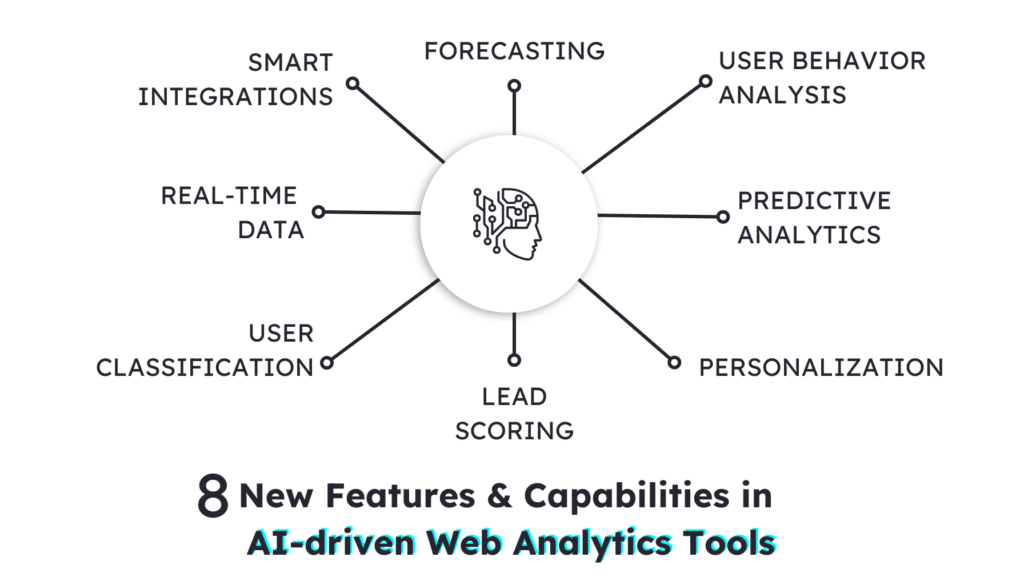
Tired of spending hours trying to figure out how Google Analytics 4 (GA4) works?
Don’t worry, you’re not the only one. On top of being complicated to understand, Google Analytics is constantly changing, which makes it hard to keep up with.
Exciting trends are rising in the world of website analytics, things that will take you way beyond Google Analytics 4 (and the headaches that come with it).
GA4 relies on cookies to track user behavior, which means that it may not be compatible with all websites and businesses. As a result, you might want to start looking into alternative web analytics solutions that are easier to use, more privacy-friendly, and don’t require cookies.
Table of Contents
What Makes Google Analytics 4 so Complicated?
You’ve likely encountered the complex terrain of Google Analytics 4 (GA4) yourself. The transition from Universal Analytics (UA) to GA4 came with its fair share of challenges for us marketers, leaving many scratching their heads in frustration.
Tracking Migration Headache
One of the foremost headaches is the migration from UA to GA4. The process demands time, effort, and a meticulous approach. The fear of losing valuable historical data during this transition further compounds the stress. Many marketers have said to have found inconsistent data when comparing their existing UA numbers with the ones in their new GA4.
Installation Hurdles
Installing GA4 isn’t a walk in the park either. Marketers often find themselves going through complicated setups and technical complexities, investing hours that could be better spent on strategic tasks. The learning curve for GA4 can be steep, deterring users from harnessing its full potential.
Inconsistent Data in GA4 Compared to UA
Upon successful installation, another challenge arises – the inconsistency in data when compared with UA. Questions about the reliability of GA4’s data start to surface, creating doubt about its trustworthiness. Marketers are left wondering, can the data in GA4 be trusted for making critical business decisions?
Dependency on Legacy Tracking Systems
GA4’s dependence on third-party cookies and fading tracking pixels raises concerns about data accuracy and user privacy. GA4’s reliance on an aging technology jeopardizes its ability to provide seamless cross-platform tracking.
So, where do you turn when GA4 becomes more of a headache than a solution? The answer lies in exploring alternative web analytics tools that not only address these challenges but also offer a refreshing approach to data analysis. Tools that incorporate upcoming trends in the realm of analytics.
Understand your customer journey analytics
See how your users behave, find drop-offs, and receive actionable insights with AI.

3 Trends Shaping the Future of Web Analytics
In web analytics, three trends stand out as the driving force. Artificial Intelligence (AI) and Machine Learning (ML), the escalating emphasis on customer privacy, demanding a strategic shift, and finally the growing importance of omnichannel analytics, ensuring an understanding of customer journeys in an evolving digital world. Let’s dive into these trends shaping the analytics landscape.
1. The Rise of Artificial intelligence (AI) and machine learning (ML)
AI and ML are not just trends but pivotal tools reshaping how you collect, analyze, and interpret data, propelling you toward more accurate and actionable insights that are game-changers for website enhancement and marketing strategies.
2. The Increasing Focus on Customer Privacy
As consumers become more aware of their privacy rights, websites are under increasing pressure to collect and use data responsibly. Web analytics tools are evolving to meet this need, providing businesses with ways to track user behavior without compromising their privacy.
Third-party cookies have long been integral to website analytics, enabling you to track user behavior across various websites. However, they’re bound to disappear, driven by a growing acknowledgment of their potential to compromise user privacy. In response to this shift, web analytics tools are undergoing significant transformations to align with privacy-conscious practices. These tools are exploring innovative methods that enable businesses to continue tracking user behavior effectively while respecting user privacy.
3. The Growing Importance of Omnichannel Analytics
Customers are increasingly interacting with your business across many different channels: websites, mobile apps, and social media… Website analytics tools need to be able to track this cross-channel behavior to provide you with a complete view of your customer’s journey, taking into account the fact that you can’t rely on third-party cookies and tracking pixels for much longer.
New Features and Capabilities in Website Analytics Tools

A lot of analytics tools are becoming better alternatives to Google Analytics 4. Easier to use, privacy-friendly, applicable insights…
Some solutions are exploring new capabilities, but the best ones should definitely be able to provide you with:
AI-Powered Forecasting
AI-powered predictive analytics enables you to identify trends and predict future outcomes. This information can be used to make better decisions about everything from product development to marketing campaigns.
New web analytics solutions offer predictive metrics that utilize machine learning algorithms to forecast user behavior, helping you proactively adjust your strategy. By identifying patterns and correlations in data, these tools provide actionable insights for you to make informed decisions in areas such as product development and marketing campaign planning.
Automated User Behavior Analysis
AI-driven algorithms automate the analysis of user behavior, discerning patterns and anomalies in real time. This automation eliminates the manual effort required for interpreting data, allowing you to benefit from immediate, actionable insights.
Predictive Analytics
Powered by AI, they enable you to foresee trends and anticipate future user behavior. From forecasting website traffic fluctuations to predicting potential conversions, this predictive capability empowers you to make informed decisions ahead of the curve.
Dynamic Personalization
AI and machine learning enable you to dynamically personalize user experiences. By understanding individual preferences and engagement histories, tools like Pathmonk Accelerate tailor content recommendations, optimizing the user journey and increasing the likelihood of conversion.
AI-Enhanced Lead Scoring
By using AI to assign predictive lead scores, indicating the likelihood of a visitor becoming a qualified lead. This automated lead-scoring process streamlines the identification of high-value prospects, allowing you to prioritize and tailor your outreach efforts effectively.
User Behavior Classification for Personalized Experiences
AI algorithms are revolutionizing the understanding of user behavior on websites. By analyzing data patterns, machine learning models can automatically classify user behavior, discerning between different types of interactions.
For instance, Pathmonk utilizes AI to classify users into distinct segments based on their behavior, enabling you to tailor personalized experiences that resonate with specific audience segments.
Real-Time Data Processing
Real-time data processing allows you to get insights into your website traffic and customer behavior as it happens. This information can be used to make immediate adjustments to your websites and marketing campaigns.
Traditional analytics platforms often operate on delayed reporting, leaving you grappling with outdated information. Tools like Pathmonk Intelligence disrupt this norm by providing immediate visibility into user behavior as it unfolds.
Integration with Other Marketing and Sales Tools
Web analytics tools are increasingly integrated with other marketing and sales tools, such as CRM systems and marketing automation platforms. This makes it easier for you to get a complete view of your customers and their interactions with your website.
How Will This Change the Way You Should Use Website Analytics?

The changes that are happening in website analytics will have a significant impact on how you should use web analytics to make decisions and improve your performance. Here are a few things to take into account:
Make the Most Out of AI and Machine Learning
AI-powered tools can now automatically identify and classify user behavior, spot trends, and anomalies, and even predict future customer behavior. Leading to more accurate and actionable insights that you can use to improve your websites and marketing campaigns. Make sure to look for AI-powered solutions when searching for your new web analytics tool.
Focus on Customer Privacy
Many web analytics tools now offer anonymization features that allow you to track user behavior without collecting personally identifiable information (PII). More and more businesses are turning towards cookieless solutions, to make sure that they’re ready for the upcoming regulations.
As a business owner, it’s important to be transparent about how you collect and use customer data. You should also make it easy for customers to opt out of data collection if they wish.
Try Omnichannel Analytics
Website analytics tools need to be able to track this cross-channel behavior to provide you with a complete view of your customer’s journeys.
Google Analytics 4 currently requires the use of a tracking pixel to be able to give you access to these omnichannel insights. A tracking pixel is a tiny, invisible image embedded in a web page or email. It’s used to quietly track user activity and provides you with the most accurate insights. But much like third-party cookies, tracking pixels are bound to disappear.
These old-school methods not only mess up smooth cross-platform tracking but also mess with how accurate your data is and with your users’ privacy. Jumping on board with analytics solutions that go beyond the pixel isn’t just a tech upgrade; it’s a must-do strategy.
The Future of Web Analytics is Now with Pathmonk Intelligence
Pathmonk Intelligence is a web analytics tool that is designed to be easy to use and future-proof. It uses AI and ML to provide you with actionable insights that you can use to improve your websites and marketing campaigns.
Pathmonk Intelligence offers several advantages compared to Google Analytics 4:
Easier to Use: Pathmonk Intelligence has a user-friendly interface that makes it easy to get started and get insights. Say goodbye to steep learning curves; this tool is designed for seamless onboarding, ensuring that users of all technical levels can harness its power effortlessly.
More Privacy-Friendly: It is designed to be privacy-friendly, giving businesses control over how their data is collected and used. Operating without cookies, it ensures compliance with evolving privacy regulations while safeguarding user data responsibly. Your data remains accurate, your reputation intact, and your users’ privacy respected.
More Precise: The solution employs a sophisticated AI-powered algorithm dedicated to precisely attributing data. This means you gain incredible accuracy in tracking the impact of marketing channels and campaigns, providing invaluable insights to optimize your strategies effectively.
Easier to Set Up: Pathmonk Intelligence simplifies event tracking by automating the entire process. Every user action is meticulously monitored without necessitating intricate setups, significantly reducing technical overhead. This streamlined approach ensures a comprehensive understanding of your user interactions without you having to spend days setting it up and maintaining it.
No Need for Developers: One of Pathmonk Intelligence’s standout features is its integration into websites without necessitating developer involvement. This level of autonomy empowers you to take control of your analytics processes without relying on your technical team.
Sign up for a free trial today and see how Pathmonk Intelligence can help you improve your website and marketing campaigns.





